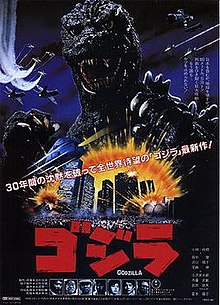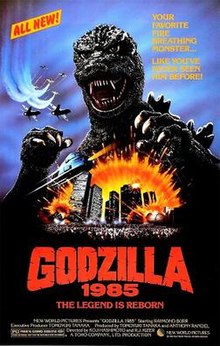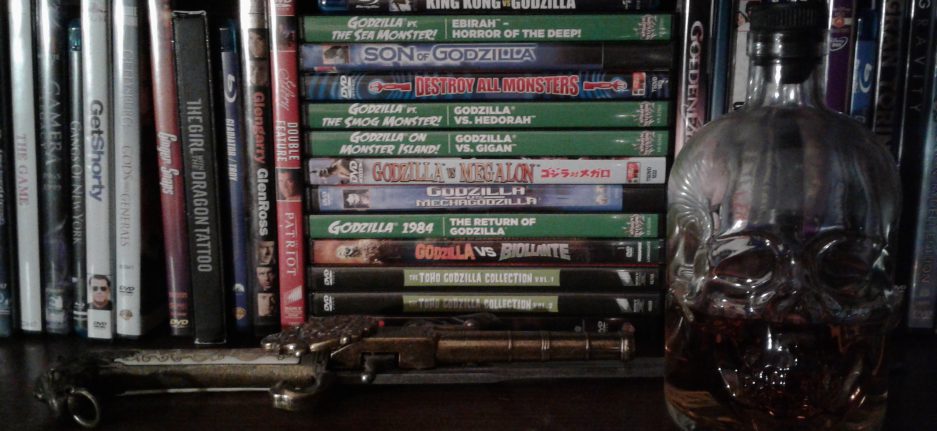Following Terror of Mechagodzilla’s poor returns, the Godzilla franchise found itself on indefinite unofficial hiatus. Several ideas were pitched, including Godzilla vs the Devil and a film pitting the Big G against a shape-shifting foe, but these were never able to materialize, keeping the franchise in limbo. In the early ‘80s, an American Godzilla film almost got off the ground, but the director insisted on using stop-motion animation and filming in 3D, effectively stifling studio interest. At last, Toho finally got its shit together, moving forward with a 30th-anniversary project that aimed to take Godzilla away from the child-friendly nonsense that colored the Showa era and back toward the monster’s original, dark, anti-nuclear roots. The end result would be known officially in Japan as Gojira, but, since they were more sensitive to confusion back then – and because they wanted to not only reboot the series, but also make a direct sequel to the original film – it was also known as The Return of Godzilla (or even Godzilla 1984, though that title instantly brings to mind notions of a kaiju-laden dystopia wherein Winston Smith must work against the government propaganda that Oceania has always been at war with King Ghidorah and always friends with Godzilla, and anyone who says otherwise is a traitor to the party and to the state, which just sounds both terrible and badass, amiright?).

The story tells of a second coming of a Godzilla creature, spurred to arise because of a volcanic eruption. He sinks a fishing vessel, instigating some pre-emptive anti-Godzilla preparations amongst the Japanese authorities, and a Soviet nuclear submarine before eventually coming ashore and stirring up trouble on the mainland. In response, the military has created a flying superfortress known as the Super X, a titanium-coated vessel armed with cadmium rounds designed to contain Godzilla’s nuclear power source. After some hefty destruction, the authorities are able to lure the monster into an active volcano and trigger an eruption, sending the monster to a magma-soaked end.
In my eyes, the studio succeeded at returning the series to its dark roots. Godzilla is back to being a relentless mechanism of destruction, seemingly taking the lives of hundreds as he rampages through downtown Tokyo. The film also establishes Godzilla as a potential global threat, including the Cold War superpowers in negotiations concerning killing the monster. In fact, the anti-nuclear stance of the franchise shines through, with the Japanese government refusing to allow either the Soviets or the Americans to deploy nuclear weapons on Japanese soil (can’t imagine why). Funnily enough, though, the Soviets – who are abrogating all sorts of arms control treaties by having a nuclear launch site hidden on a Russian shipping boat in Tokyo harbor and, worse, having space-based nukes – accidentally launch a missile (in spite of a Russian official vainly trying to thwart the launch), requiring an American interception, which, in turn, helps to revitalize an ailing Godzilla.
The film is downright great, if you ask me (and, clearly, you did, many times). The special effects are outstanding, though some of the close-up shots of Godzilla’s head reveal some of the suit’s shortcomings (those eyes…they’re just so glassy…). The script actually feels like some thought was put into it, particularly with the hefty amount of human-centric plot, and it truly feels as though the spark has returned to the series.
Feeling the swagger of success, Toho looked to shop the film around to international distributors. Unfortunately, they couldn’t find proper support, leading them to ultimately go with Roger Corman’s New World Pictures. This would have some negative repercussions for the American release of the film: First off, the studio wanted to basically re-dub the film and turn it into a full-on comedy. Think What’s Up, Tiger Lily? with kaiju. Thankfully, the decision to bring Raymond Burr back to reprise his role from King of the Monsters precluded this, as Burr refused to go along with the plan, believing in the film’s actually-serious anti-nuclear messaging. Instead, New World decided to follow in King of the Monsters’s footsteps and film a separate set of English scenes to splice in with a re-edited and dubbed version of the Japanese film. What resulted would be known as Godzilla 1985.

The essential elements of the story remain in this version, just with heavy involvement from Burr and the other American actors, often watching things transpire on screens and reacting thereto. I still get my Godzilla traipsing through Tokyo hellbent on fucking shit up, and I still get my iconic ending with Godzilla tumbling into an open volcano (still the clearest memory I have from my first viewing, oddly enough); there’s just more padding en route. There’s also some interesting Cold War shenanigans being presented, with the Russians now purposely launching the nuke (often attributed to New World’s head’s highly conservative politics during the Cold War’s last peak), and there were even rumors of different cuts suggesting different missile launches, but these turned out to be false. Oh, and there was a massive amount of Dr. Pepper product placement, ‘cause why the hell not? At least it gave us some wacky commercial shots like this one:

Godzilla 1985 is definitely a shadow of its Japanese predecessor, much like King of the Monsters couldn’t live up to the promise of Gojira. It’s still mostly fine, and G-fans will still find plenty to enjoy here, but there’s just so much cheap worthlessness thrown in to try to make the film more amenable to American audiences (‘cause who wants to read subtitles, or watch a legit dub, right?). Sad to say, this version did rather poorly, both at the box office and among critics, and this failure is largely credited for the lack of theatrical Godzilla releases for the next fifteen-ish years, keeping fans like Young Me to flit through specialty stores and libraries in order to get a glimpse of the next several films in the series.
Still, things got off to a strong start for this new era, the Heisei era, and they’d continue along this path with Godzilla’s next appearance in a few years.
